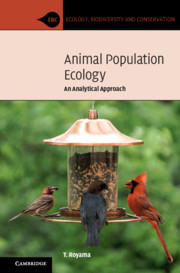Book contents
- Animal Population Ecology
- Ecology, Biodiversity and Conservation
- Animal Population Ecology
- Copyright page
- Dedication
- Contents
- Prologue
- 1 Hunting Strategies of Predators as Revealed in Field Studies of Great Tits
- 2 The Paradox of Crypsis: Is it Effective against Visual Predation?
- 3 Logistic Law of Population Growth: What Is It Really?
- 4 Reproduction Curves and Their Utilities
- 5 Generalization of the Logistic Model
- 6 Scramble and Contest Competition: What Is the Difference?
- 7 Regulation of Populations: Its Myths and Real Nature
- 8 Predator–Prey Interaction Processes
- 9 Interspecific Competition Processes
- 10 Observations, Analyses, and Interpretations: A Personal View through the Spruce Budworm Studies
- References
- Index
7 - Regulation of Populations: Its Myths and Real Nature
Published online by Cambridge University Press: 01 April 2021
- Animal Population Ecology
- Ecology, Biodiversity and Conservation
- Animal Population Ecology
- Copyright page
- Dedication
- Contents
- Prologue
- 1 Hunting Strategies of Predators as Revealed in Field Studies of Great Tits
- 2 The Paradox of Crypsis: Is it Effective against Visual Predation?
- 3 Logistic Law of Population Growth: What Is It Really?
- 4 Reproduction Curves and Their Utilities
- 5 Generalization of the Logistic Model
- 6 Scramble and Contest Competition: What Is the Difference?
- 7 Regulation of Populations: Its Myths and Real Nature
- 8 Predator–Prey Interaction Processes
- 9 Interspecific Competition Processes
- 10 Observations, Analyses, and Interpretations: A Personal View through the Spruce Budworm Studies
- References
- Index
Summary
In the 1950s, there was a hot debate among ecologists about what regulates animal populations so as to keep them persisting for a long time. The participants of the debate were divided into two schools of thought, one insisting on the importance of climatic factors and the other emphasizing the necessity of density-dependent biotic factors. Albeit an important subject, no clear answers came out of the debate. A fundamental problem in the indecisive debate lay in the lack of clear definitions of ‘regulation’ and ‘persistence’ of populations. Consequently, the current ecological thoughts inherit many myths and ambiguities about the nature of population regulation. Here, I delve into the subject to look for unambiguous answers. In particular, I show that a climatic (density-independent) control of populations is theoretically possible but fragile in a fluctuating environment, and that density-dependent regulation is necessary but not sufficient for keeping populations in the persistent state.
Keywords
- Type
- Chapter
- Information
- Animal Population EcologyAn Analytical Approach, pp. 145 - 180Publisher: Cambridge University PressPrint publication year: 2021

